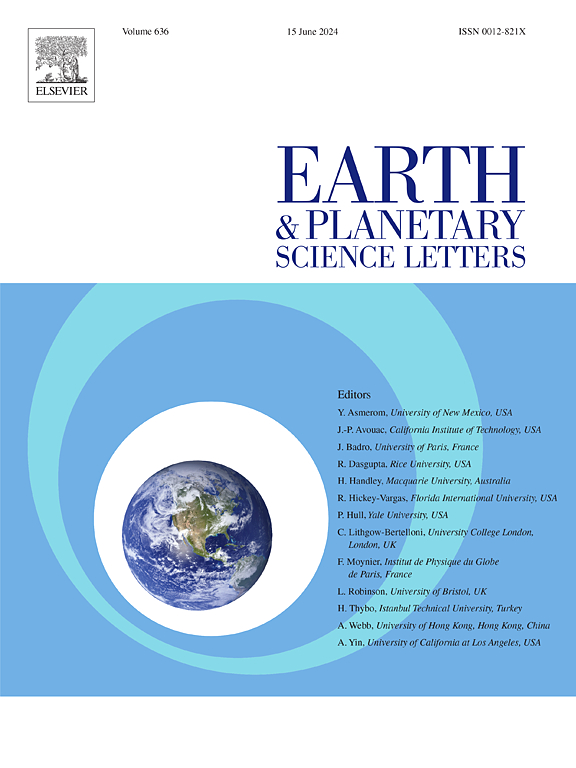从地幔对流和冰川等静力调整过程推断地幔粘度的长期难题
IF 4.8
1区 地球科学
Q1 GEOCHEMISTRY & GEOPHYSICS
引用次数: 0
摘要
地幔粘度对地幔和岩石圈的长期(即106年)动力学以及由冰融化、海平面变化和地震等加载力引起的短期(即10至104年)地壳运动具有重要的控制作用。然而,从与地幔动力学和加载过程相关的模拟观测中推断出的地幔粘度结构可能存在很大差异,这也是近几十年来一直争论不休的话题。在本研究中,我们通过考虑地幔对流和冰川等静力调整(GIA)模型中五个具有代表性的地幔粘度结构,研究地幔粘度结构对大地水准面、地幔结构以及当今地壳运动和时变重力观测的影响。这五个粘性模型分为两类:1)地幔对流模型中的大地水准面建模得到的两个粘度模型,其下地幔粘度是上地幔的100倍;2)其他三个模型,其上地幔到下地幔的粘度增加较少,这些模型是在冰川等静力调整模型中模拟晚更新世和全新世相对海平面变化和其他观测结果得到的。我们的对流模型利用过去 130 Myrs 的板块运动历史作为地表边界条件,并利用与深度和温度相关的粘度来预测俯冲板块和中间波长(4-12 度)大地水准面的现今对流地幔结构。我们的 GIA 模型使用不同的冰历史模型(如 ICE-6 G 和 ANU)计算 GIA 引起的当今地壳运动和时变重力。我们的计算表明,虽然下地幔粘度较高的粘度模型(∼2 × 1022 Pa.s)重现了 4-12 度大地水准面和地震板块结构,但它们对地壳运动和时变重力的大地测量(即 GPS 和 GRACE)观测结果的预测明显偏高。我们的计算还表明,虽然用平均地幔粘度 ∼1021 Pa.s(地幔顶部 1200 公里)拟合 RSL 数据得到的两个粘度模型很好地再现了大地测量观测结果,而与冰模型无关,但它们无法解释大地水准面和地震板块结构。因此,我们的研究凸显了从不同观测数据中得出的地幔粘度结构这一长期存在的难题。我们还讨论了一些可能的方法,包括瞬态粘度、应力依赖粘度和三维粘度,以解决地球动力学中的这一重要问题。本文章由计算机程序翻译,如有差异,请以英文原文为准。
The persisting conundrum of mantle viscosity inferred from mantle convection and glacial isostatic adjustment processes
Mantle viscosity exerts important controls on the long-term (i.e., >106 years) dynamics of the mantle and lithosphere and the short-term (i.e., 10 to 104 years) crustal motion induced by loading forces including ice melting, sea-level changes, and earthquakes. However, mantle viscosity structures inferred from modeling observations associated with mantle dynamic and loading processes may differ significantly and remain a hotly debated topic over recent decades. In this study, we investigate the effects of mantle viscosity structures on observations of the geoid, mantle structures, and present-day crustal motions and time-varying gravity by considering five representative mantle viscosity structures in models of mantle convection and glacial isostatic adjustment (GIA). These five viscosity models fall into two categories: 1) two viscosity models derived from modeling the geoid in mantle convection models with ∼100 times more viscous lower mantle than the upper mantle, and 2) the other three with less viscosity increase from the upper to lower mantles that are derived from modeling the late Pleistocene and Holocene relative sea level changes and other observations in GIA models. Our convection models use the plate motion history for the last 130 Myrs as the surface boundary conditions and depth- and temperature-dependent viscosity to predict the present-day convective mantle structure of subducted slabs and the intermediate wavelength (degrees 4–12) geoid. Our GIA models using different ice history models (e.g., ICE-6 G and ANU) compute the GIA-induced present-day crustal motions and time-varying gravity. Our calculations demonstrate that while the viscosity models with a higher viscosity in the lower mantle (∼2 × 1022 Pa.s) reproduce the degrees 4–12 geoid and seismic slab structures, they significantly over-predict the geodetic (i.e., GPS and GRACE) observations of crustal motions and time varying gravity. Our calculations also show that while two viscosity models derived from fitting the RSL data with averaged mantle viscosity of ∼1021 Pa.s for the top 1200 km of the mantle reproduce well the geodetic observations independent of ice models, they fail to explain the geoid and seismic slab structures. Therefore, our study highlights the persisting conundrum of mantle viscosity structures derived from different observations. We also discuss a number of possible ways including transient, stress-dependent and 3-D viscosity to resolve this important issue in Geodynamics.
求助全文
通过发布文献求助,成功后即可免费获取论文全文。
去求助
来源期刊

Earth and Planetary Science Letters
地学-地球化学与地球物理
CiteScore
10.30
自引率
5.70%
发文量
475
审稿时长
2.8 months
期刊介绍:
Earth and Planetary Science Letters (EPSL) is a leading journal for researchers across the entire Earth and planetary sciences community. It publishes concise, exciting, high-impact articles ("Letters") of broad interest. Its focus is on physical and chemical processes, the evolution and general properties of the Earth and planets - from their deep interiors to their atmospheres. EPSL also includes a Frontiers section, featuring invited high-profile synthesis articles by leading experts on timely topics to bring cutting-edge research to the wider community.
 求助内容:
求助内容: 应助结果提醒方式:
应助结果提醒方式:


